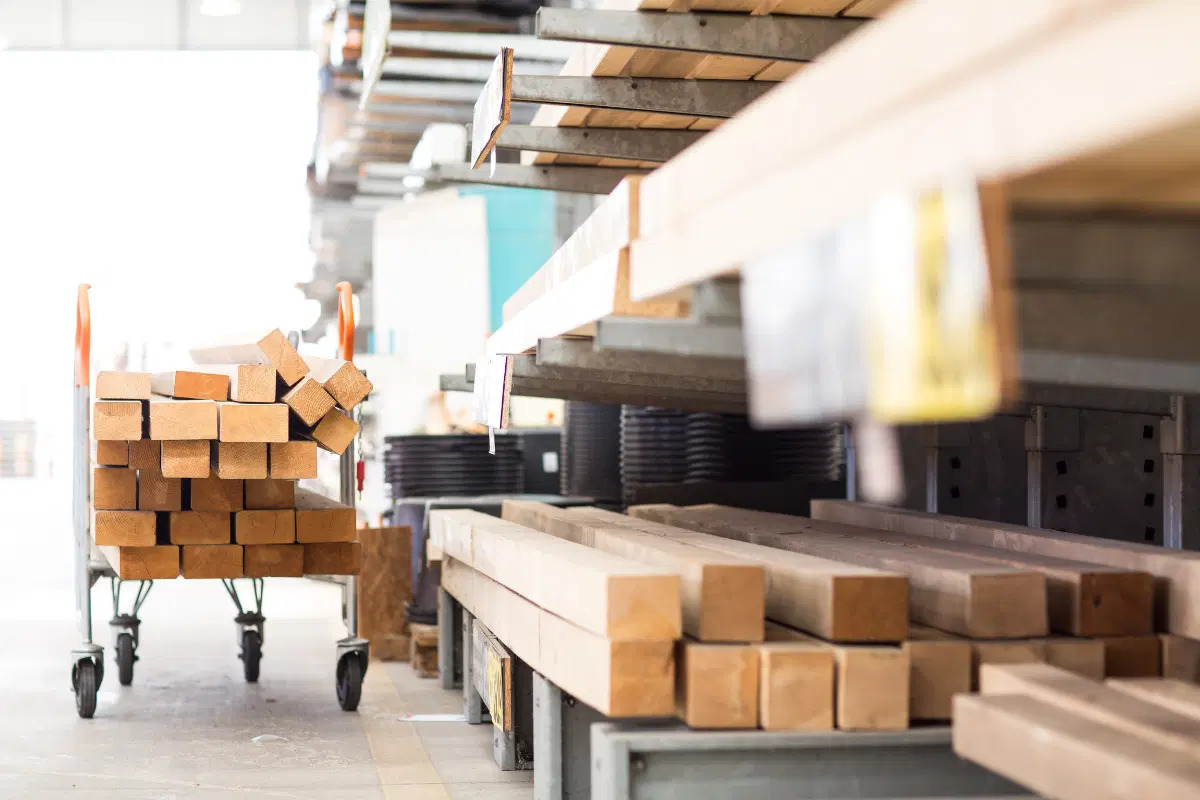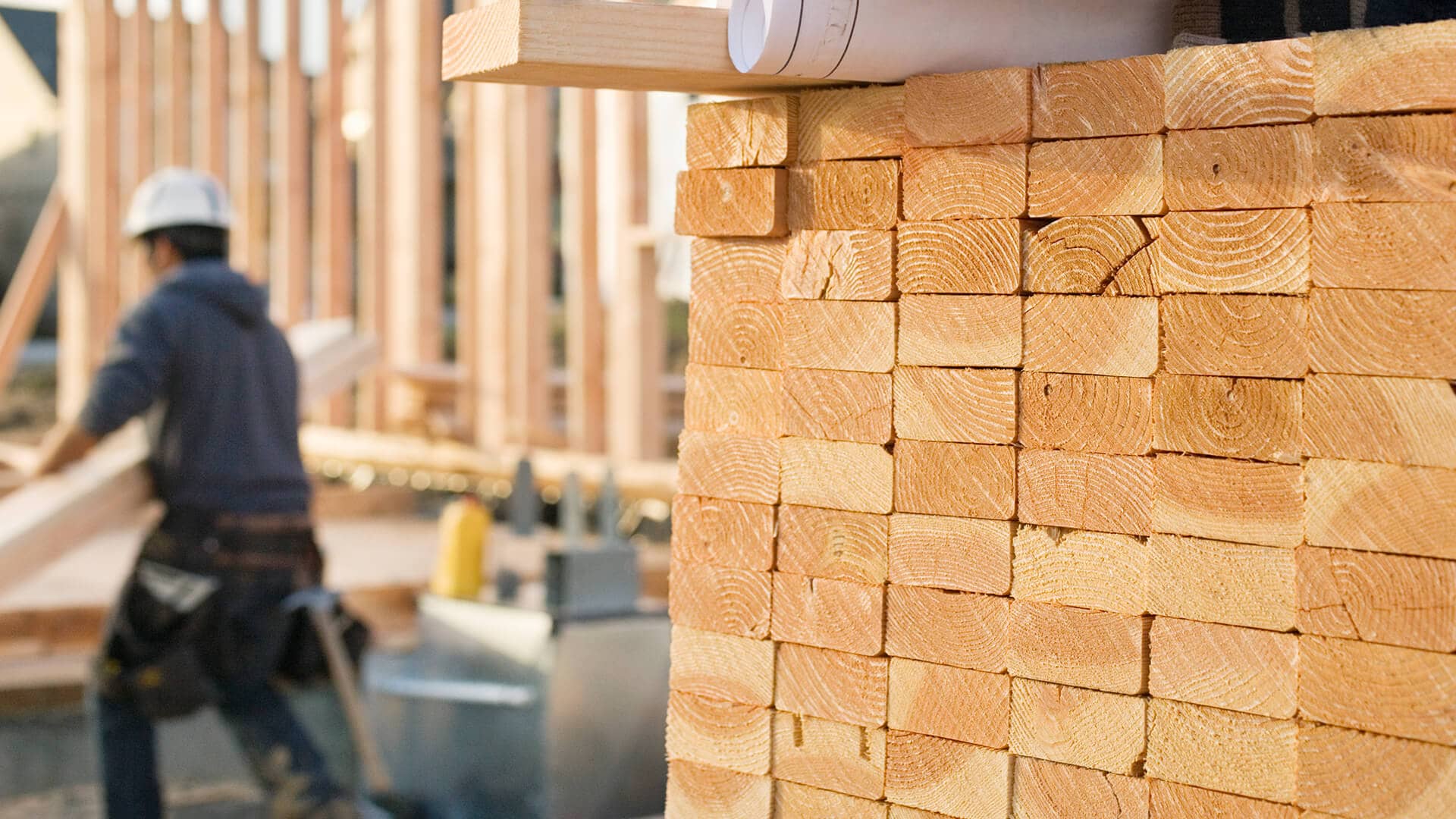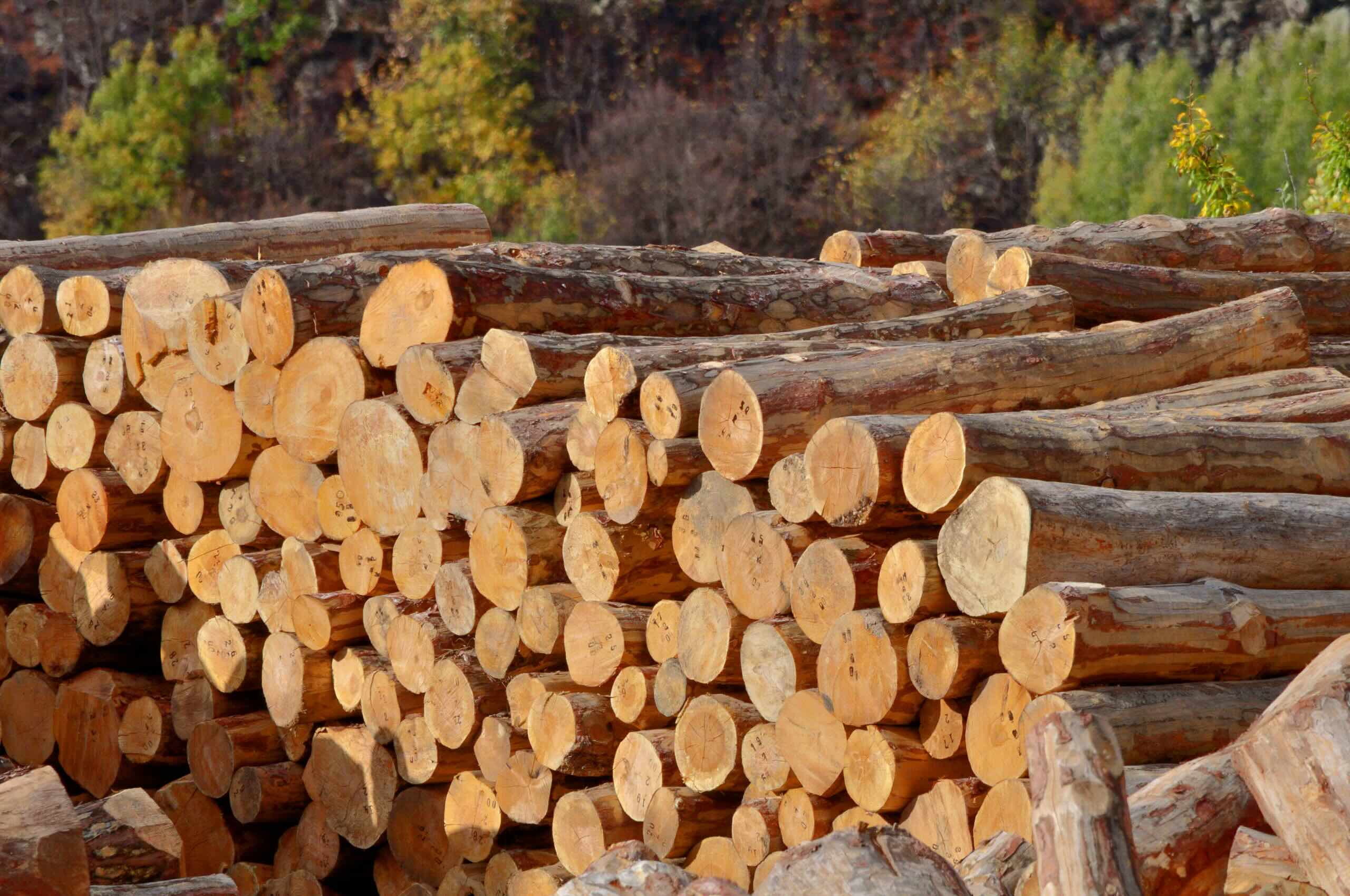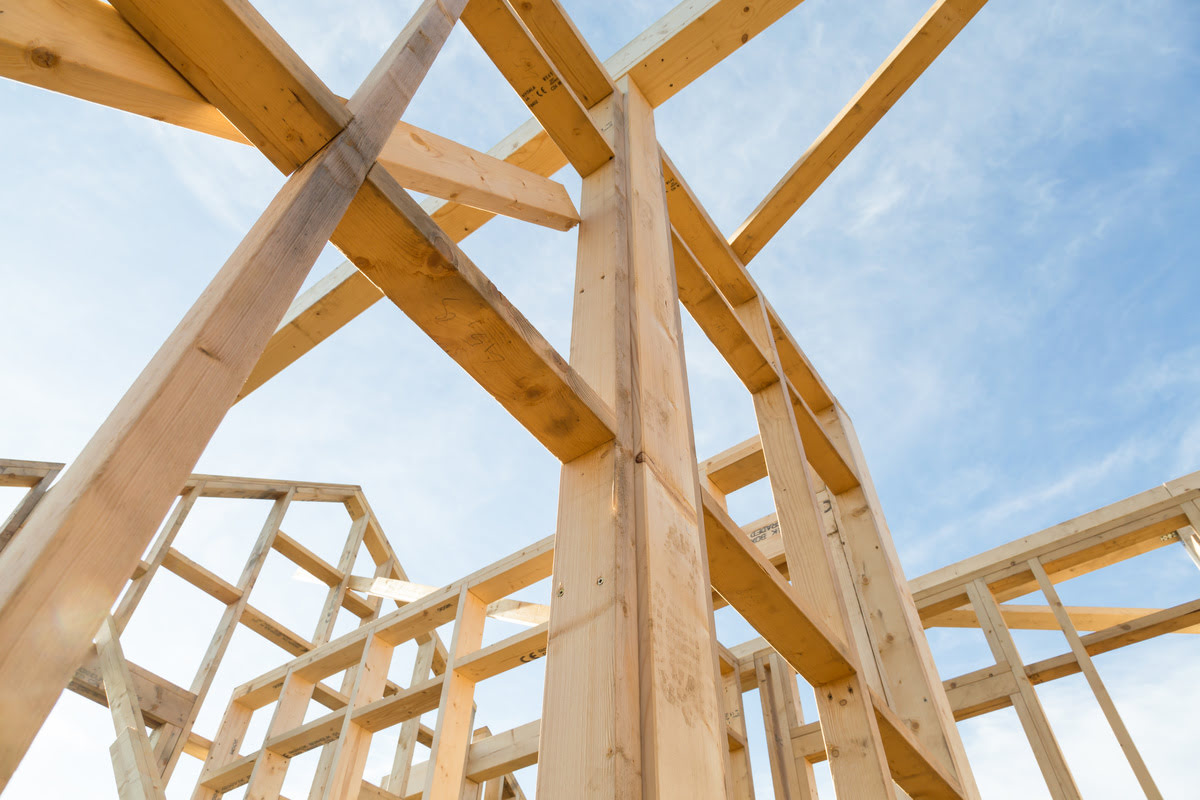Home>diy>Building & Construction>What Is The Most Common Wood Used In Construction


Building & Construction
What Is The Most Common Wood Used In Construction
Modified: January 2, 2024
Discover the most common wood used in building construction and why it is a popular choice for structural projects. Enhance your knowledge of wood materials.
(Many of the links in this article redirect to a specific reviewed product. Your purchase of these products through affiliate links helps to generate commission for Storables.com, at no extra cost. Learn more)
Introduction
Wood has been a staple material in construction for centuries. Its versatility, strength, and natural beauty make it an ideal choice for various building projects. From residential homes to commercial structures, wood has proven its durability and reliability over time.
In addition to its aesthetic appeal, wood offers several advantages over other construction materials. It is lightweight, easy to work with, and has excellent insulation properties. Furthermore, wood is a renewable resource, making it an environmentally friendly choice for sustainable construction practices.
In this article, we will explore the importance of wood in construction and delve into the most common wood species used in building projects. We will also discuss the benefits of using these species, as well as the limitations and sustainable practices associated with wood construction.
Whether you are planning a small home renovation or a large-scale commercial project, understanding the characteristics and applications of different wood species will help you make informed decisions and achieve excellent results. Let’s dive into the world of wood construction and discover the most common species used in the industry.
Key Takeaways:
- Wood is a versatile, durable, and sustainable material in construction, offering benefits such as strength, design flexibility, and environmental friendliness. Understanding wood species and sustainable practices is crucial for successful building projects.
- Incorporating responsible sourcing, optimized material usage, and energy-efficient designs can enhance the sustainability of wood construction. By embracing these practices, builders can ensure the long-term viability of forests and minimize environmental impact.
Importance of Wood in Construction
Wood plays a vital role in the construction industry, offering numerous benefits that make it a preferred choice for builders and homeowners alike. Here are some key reasons why wood is important in construction:
- Strength and Durability: Wood is known for its remarkable strength-to-weight ratio, making it structurally sound and capable of withstanding heavy loads. When properly maintained, wooden structures can last for decades or even centuries. This durability is especially important in earthquake-prone areas, where wood’s flexibility can better absorb the impact.
- Renewable and Sustainable: Wood is a renewable resource that can be sustainably harvested, making it an eco-friendly choice for construction. Forests can be responsibly managed to ensure new growth and replenishment. Furthermore, wood stores carbon dioxide, helping to reduce greenhouse gas emissions and mitigate climate change.
- Insulation Properties: Wood naturally provides excellent thermal insulation, helping to regulate indoor temperature and reduce energy consumption. It has low thermal conductivity, meaning that heat is not easily transferred through wood, making it a valuable asset in creating energy-efficient buildings.
- Design Flexibility: Wood offers endless design possibilities, allowing for both traditional and contemporary architectural styles. Its natural warmth and beauty add a touch of elegance to any structure. Wood can be easily shaped, carved, and crafted, enabling intricate detailing and customized elements.
- Cost-effectiveness: Wood is often more affordable than other building materials, such as steel or concrete. The availability of different wood species at various price points makes it a versatile option for projects with diverse budgets. Additionally, wood is relatively easy to work with, reducing labor costs and construction time.
- Health and Well-being: Wood has been shown to have positive effects on human health and well-being. Its natural characteristics, such as its ability to regulate humidity and improve indoor air quality, contribute to a healthier and more comfortable living environment. Studies have even suggested that exposure to wood can reduce stress levels and promote relaxation.
Considering these factors, it is clear why wood continues to be a popular choice in the construction industry. Its combination of strength, sustainability, versatility, and affordability makes it an indispensable material in building projects of all sizes and scopes.
Factors to Consider When Choosing Wood for Construction
Choosing the right wood for a construction project is essential to ensure the longevity, aesthetics, and functionality of the structure. Here are some key factors to consider when selecting wood for construction:
- Strength and Structural Requirements: Evaluate the load-bearing requirements of the project and choose a wood species with the necessary strength and structural integrity. Different species have varying levels of strength and durability, so it’s important to match the wood to the specific application.
- Moisture Resistance: Consider the moisture level of the project site and choose a wood species that can withstand those conditions. Moisture-resistant woods, such as cedar or redwood, are suitable for applications in humid or wet environments.
- Insect and Pest Resistance: Some wood varieties, like pressure-treated wood, are treated with chemical preservatives to prevent insect and pest infestations. If the project is in an area prone to termites or other wood-damaging pests, selecting a treated wood species is advisable.
- Dimensional Stability: Wood expands and contracts as it absorbs and loses moisture. Choose a wood species with good dimensional stability to minimize warping, twisting, or splitting in response to humidity and temperature changes.
- Aesthetics: Consider the desired look and feel of the finished project. Different wood species have distinct colors, grain patterns, and textures that contribute to the overall aesthetic appeal. Select a species that complements the architectural style and desired design aesthetic.
- Availability and Cost: Evaluate the availability and cost of the wood species in your region. Some wood species may be more readily available and affordable than others, depending on the location. Consider the project budget and the feasibility of sourcing the desired wood species.
- Maintenance Requirements: Different wood species have varying levels of maintenance requirements. Consider how much time and effort you are willing to dedicate to routine maintenance, such as staining, sealing, or periodic treatments, to keep the wood in optimal condition.
- Sustainability: Assess the sustainability and environmental impact of the wood species. Look for wood that is certified by organizations like the Forest Stewardship Council (FSC), indicating that it comes from responsibly managed forests.
- Local Building Codes and Regulations: Ensure that the selected wood species complies with local building codes and regulations. Some areas may have restrictions or specific requirements regarding the use of certain wood species for construction.
Taking these factors into account and consulting with professionals, such as architects or contractors, can help you make an informed decision when choosing the right wood for your construction project. It ensures that the chosen wood species aligns with the project’s specific needs, environment, and aesthetic goals, resulting in a successful and long-lasting construction endeavor.
Most Common Wood Species Used in Construction
Various wood species are utilized in construction, each with its own unique characteristics and applications. The choice of wood species depends on factors such as strength requirements, durability, availability, and aesthetic preferences. Here are some of the most common wood species used in construction:
Softwoods:
1. Pine: Pine is a widely available and affordable softwood that is commonly used in construction. It is known for its light color, straight grain, and durability. Pine is often utilized in framing structures, interior trim, and furniture.
2. Spruce: Spruce is another popular softwood used in construction. It is known for its strength, stiffness, and light color. Spruce is commonly used in roof trusses, interior framing, and general construction applications.
3. Douglas Fir: Douglas Fir is a strong and durable softwood known for its excellent load-bearing capacities. It is often used in structural applications such as beams, joists, and decking. Douglas Fir has a distinct reddish-brown color and a pronounced grain pattern.
Hardwoods:
1. Oak: Oak is a versatile hardwood that is highly regarded for its strength and durability. It comes in two major varieties: red oak and white oak. Oak is commonly used in flooring, cabinetry, furniture, and decorative elements due to its attractive grain pattern and natural beauty.
2. Maple: Maple is a dense and durable hardwood known for its light color and smooth texture. It is commonly used in flooring, cabinets, millwork, and furniture. Maple’s tight grain makes it ideal for creating a smooth, polished surface.
3. Mahogany: Mahogany is a popular hardwood known for its rich, reddish-brown color and exceptional beauty. It is highly valued for its durability, resistance to rot, and insect resistance. Mahogany is often used in high-end applications such as furniture, cabinetry, and exterior trim.
4. Walnut: Walnut is a dark-colored hardwood renowned for its rich, deep brown tones and striking grain patterns. It is commonly used in high-quality furniture, cabinetry, flooring, and decorative accents. Walnut’s natural beauty and elegance make it a sought-after wood species in construction.
These are just a few examples of the most common wood species used in construction. However, there are numerous other wood species with their own unique characteristics and applications. It is essential to carefully consider the specific requirements of your construction project and consult with professionals to determine the best wood species for your needs.
Softwoods
Softwood is a type of wood that comes from coniferous trees, which are characterized by their needle-like leaves and cones. Softwoods are widely used in construction due to their availability, affordability, and excellent strength-to-weight ratio. Here are some common softwood species used in construction:
Pine:
Pine is one of the most commonly used softwoods in construction. It is known for its light color, straight grain, and durability. Pine is readily available and affordable, making it a popular choice for various applications. It is often used in framing structures, interior trim, decking, and furniture.
Spruce:
Spruce is another popular softwood that is widely used in construction. It is known for its strength, stiffness, and light color. Spruce has excellent load-bearing capacities, which makes it a preferred choice for roof trusses, interior framing, and general construction projects.
Douglas Fir:
Douglas fir is a strong and durable softwood species. It has excellent structural properties and is often used in applications that require high strength. Douglas fir is commonly used in beams, joists, decking, and other structural components. It has a distinctive reddish-brown color and a pronounced grain pattern.
Cedar:
Cedar is a popular softwood known for its natural beauty, durability, and resistance to rot and insect damage. It has a distinct aroma and is often chosen for its aesthetic appeal. Cedar is commonly used for siding, decking, outdoor furniture, and decorative elements in construction projects.
Softwoods have a wide range of applications in construction due to their versatility, strength, and affordability. They are particularly suitable for projects that require lightweight materials with good structural integrity. The choice of softwood species depends on specific project requirements, environmental conditions, and aesthetic preferences.
Hardwoods
Hardwood is a type of wood that comes from deciduous trees, which are characterized by their broad leaves that typically shed during the fall season. Hardwoods are known for their density, strength, and diverse range of colors and grain patterns. While hardwoods are generally more expensive than softwoods, they offer unique characteristics and are highly valued in construction. Here are some common hardwood species used in construction:
Oak:
Oak is one of the most widely used hardwood species in construction. It is known for its strength, durability, and distinct grain pattern. Oak is available in both red oak and white oak varieties, and each has its unique qualities. Oak is commonly used in flooring, cabinetry, furniture, and decorative elements due to its timeless appeal and natural beauty.
Maple:
Maple is a dense and durable hardwood that is prized for its smooth texture, light color, and excellent strength. It has a consistent grain pattern and is often used in flooring, cabinets, millwork, and furniture. Maple is favored for its ability to take stains and finishes exceptionally well and can provide a sleek and modern look to any construction project.
Mahogany:
Mahogany is a luxurious hardwood known for its deep, rich, reddish-brown color and exceptional beauty. It is highly regarded for its durability, resistance to rot, and insect resistance, making it suitable for both interior and exterior applications. Mahogany is commonly used in high-end furniture, cabinetry, decking, doors, and decorative accents.
Walnut:
Walnut is a dark-colored hardwood that is valued for its rich, deep brown tones and striking grain patterns. It has a luxurious and sophisticated look and is often used in high-quality furniture, cabinetry, flooring, and decorative accents. Walnut is also known for its workability, allowing for intricate detailing and exquisite craftsmanship.
These are just a few examples of the many hardwood species used in construction. Each hardwood species brings its unique characteristics, durability, and aesthetic appeal to the projects they are used in. The choice of hardwood species depends on factors such as project requirements, design preferences, and budget considerations.
Benefits of Using the Most Common Wood Species in Construction
Using wood as a primary construction material offers numerous advantages, and the most common wood species have specific benefits that contribute to their popularity in the industry. Here are some of the key benefits of using the most common wood species in construction:
Durability and Strength:
Many common wood species, such as oak and Douglas fir, possess excellent durability and strength properties. These woods can withstand heavy loads and provide structural stability, ensuring the longevity of the constructed project.
Design Flexibility:
Wood species like maple and walnut offer a wide range of design possibilities due to their unique grain patterns, colors, and textures. These woods can be shaped, carved, and crafted to create intricate details and customized elements, adding aesthetic appeal to any construction project.
Environmental Sustainability:
Wood is a renewable and sustainable building material, and using common wood species promotes responsible forest management. The Forest Stewardship Council (FSC) certification ensures that the wood comes from responsibly harvested forests, contributing to the conservation of forest ecosystems.
Insulation Properties:
Wood has excellent thermal and acoustic insulation properties. It naturally helps regulate indoor temperature, reducing the need for excessive heating or cooling. Furthermore, wood acts as a sound barrier, minimizing noise transmission between rooms and floors, enhancing the comfort and privacy of the occupants.
Read more: What Wood Is Used In Construction
Energy Efficiency:
Wood construction can contribute to energy efficiency in buildings. Wood is a natural insulator, reducing thermal conductivity and heat transfer. This means that less energy is required to heat or cool the interior space, resulting in lower energy consumption and reduced carbon emissions.
Healthy Indoor Environment:
Wood has been shown to have positive effects on the indoor environment and human health. It absorbs and releases moisture, helping to regulate humidity levels and improve indoor air quality. Wood also has a warm and natural feel, creating a calming and comfortable environment. Studies have even suggested that exposure to wood can reduce stress levels and improve overall well-being.
Cost-effectiveness:
Using common wood species can be cost-effective compared to other building materials. Wood is often readily available, and different wood species are available at various price points, making it suitable for a range of budgets. Additionally, wood is relatively easy to work with, reducing labor costs and construction time.
Overall, the benefits of using the most common wood species in construction include durability, design flexibility, sustainability, insulation properties, energy efficiency, a healthy indoor environment, and cost-effectiveness. These advantages make wood an ideal choice for a wide range of construction projects.
Limitations of Using Wood in Construction
While wood is a popular and versatile construction material, it does have some limitations that should be taken into consideration. Understanding these limitations can help builders and homeowners make informed decisions and ensure the success of their construction projects. Here are some of the key limitations of using wood in construction:
Moisture and Decay:
Wood is susceptible to moisture absorption, which can lead to rot, decay, and insect infestation if not properly treated or maintained. Construction projects in areas with high humidity levels or prone to moisture should implement adequate moisture barriers, ventilation systems, and regular maintenance to prevent these issues.
Fire Hazards:
Wood is combustible and can contribute to the spread and intensity of fires. However, advances in fire retardant treatments and the use of fire-resistant construction techniques can help mitigate this risk. It is essential to comply with local fire safety regulations and implement fire prevention measures in wood construction projects.
Structural Limitations:
While wood is known for its strength, it does have inherent limitations in terms of structural span and load-bearing capacities. Large, open spaces may require additional support, such as beams or columns, to ensure structural integrity. Proper structural engineering and design are crucial to optimize the use of wood in construction.
Maintenance Requirements:
Wood requires regular maintenance to preserve its appearance and structural integrity. This includes sealing, staining, and periodic treatments to protect against moisture, UV damage, and other environmental factors. Failure to properly maintain wood can result in premature deterioration and decreased lifespan of the construction project.
Read more: What Is The Most Common Type Of Yard Grass
Availability and Sourcing:
The availability and sourcing of specific wood species can vary regionally. Some exotic or specialty wood species may be more challenging to source, leading to increased costs or the need to explore alternative options. It is important to consider the local availability and sustainability of the desired wood species in construction projects.
Environmental Considerations:
While wood is a renewable resource, the unsustainable harvesting of forests can have negative environmental impacts. It is crucial to prioritize responsibly sourced wood from certified suppliers and promote sustainable forest management practices to minimize the ecological footprint of wood construction projects.
By understanding and addressing these limitations, builders and homeowners can overcome challenges associated with wood construction and ensure that the chosen wood materials are suitable for the specific project requirements and environmental conditions. With proper planning, maintenance, and adherence to safety regulations, wood can continue to be a reliable and sustainable choice in construction.
Sustainable Practices in Wood Construction
Wood is a renewable resource that, when harvested and used responsibly, can contribute to sustainable construction practices. By adopting sustainable practices in wood construction, we can ensure the long-term viability of forests and minimize the environmental impact of our building projects. Here are some key sustainable practices to consider:
1. Responsible Sourcing:
Choose wood that comes from responsibly managed forests. Look for wood that is certified by reputable organizations such as the Forest Stewardship Council (FSC). These certifications ensure that the wood is harvested using sustainable practices that prioritize the health of the forest ecosystem, biodiversity, and the rights of local communities.
2. Use Salvaged or Reclaimed Wood:
Consider using salvaged or reclaimed wood from old buildings, barns, or other structures. This not only reduces the demand for harvesting new trees but also gives new life to existing wood resources. Salvaged wood can bring character and uniqueness to a construction project while minimizing environmental impact.
3. Optimize Material Usage:
Minimize waste by optimizing the use of wood materials. Plan and design projects carefully to minimize cutting and ensure the efficient use of available resources. This can be achieved through accurate measurements, careful selection of timber sizes, and consideration of offcuts for other applications.
4. Use Engineered Wood Products:
Consider using engineered wood products such as laminated veneer lumber (LVL) or cross-laminated timber (CLT). These products are made from smaller pieces of wood bonded together, making efficient use of the timber. Engineered wood products offer strength and stability and can be used as alternatives to solid wood in many construction applications.
5. Implement Energy-Efficient Designs:
Design buildings with energy efficiency in mind. Wood has natural insulation properties, reducing the need for excessive heating or cooling. Incorporate proper insulation, efficient windows, and passive design strategies to maximize energy efficiency and reduce overall energy consumption.
6. Proper Maintenance:
Maintain wood structures regularly to ensure their longevity and reduce the need for premature replacements. Proper maintenance includes sealing, staining, and periodic treatments to protect against moisture, UV damage, and other environmental factors. This extends the lifespan of the wood and minimizes waste.
7. Recycling and Proper Disposal:
Dispose of wood waste responsibly by recycling or repurposing it whenever possible. Wood scraps can be used for various purposes, such as mulching, composting, or crafting. Additionally, if disposal is necessary, ensure that it is done in compliance with local regulations and guidelines to minimize environmental impact.
By incorporating these sustainable practices into wood construction, we can ensure the responsible use of this valuable resource. Sustainable wood construction not only helps preserve forests but also promotes the development of environmentally friendly buildings that contribute to a more sustainable future.
Conclusion
Wood is a versatile and widely used material in construction, offering numerous benefits and contributing to sustainable building practices. Throughout history, wood has proven to be a reliable and durable choice for a wide range of projects, from residential homes to commercial structures.
The importance of wood in construction cannot be overstated. Its natural beauty, strength-to-weight ratio, and insulation properties make it an ideal choice for builders and homeowners alike. Wood construction offers design flexibility, allowing for creative architectural expressions and customized elements.
While there are limitations to using wood, such as maintenance requirements and potential environmental concerns, these can be addressed through proper planning and sustainable practices. Responsible sourcing, using salvaged or reclaimed wood, optimizing material usage, and implementing energy-efficient designs are just a few examples of how we can incorporate sustainability into wood construction.
The most common wood species used in construction, including softwoods like pine and spruce, and hardwoods like oak and mahogany, each have their unique characteristics and applications. Choosing the right wood species for a construction project involves considering factors such as strength requirements, durability, aesthetic preferences, and environmental impact.
By embracing sustainable practices, we can ensure the long-term availability of wood resources and minimize the environmental impact of our building projects. Responsible forest management, using engineered wood products, and proper maintenance all contribute to the sustainable use of wood in construction.
In conclusion, wood remains a timeless and indispensable material in construction. Its versatility, strength, natural beauty, and sustainable characteristics make it a preferred choice for builders and homeowners. By leveraging the benefits of wood and adopting sustainable practices, we can create buildings that are not only functional and aesthetically appealing but also environmentally friendly and resilient.
Frequently Asked Questions about What Is The Most Common Wood Used In Construction
Was this page helpful?
At Storables.com, we guarantee accurate and reliable information. Our content, validated by Expert Board Contributors, is crafted following stringent Editorial Policies. We're committed to providing you with well-researched, expert-backed insights for all your informational needs.







0 thoughts on “What Is The Most Common Wood Used In Construction”